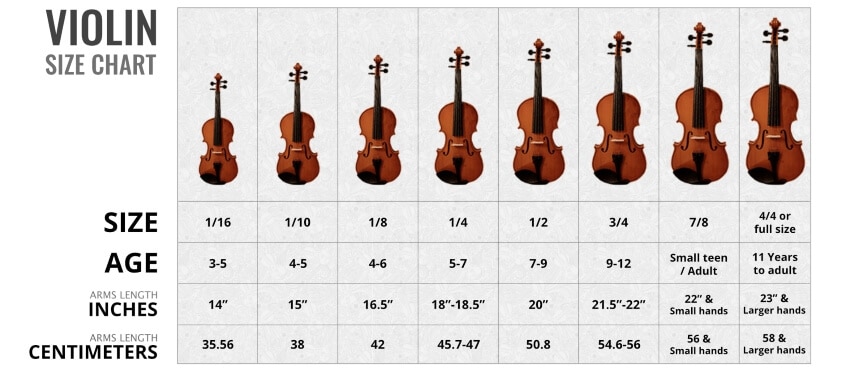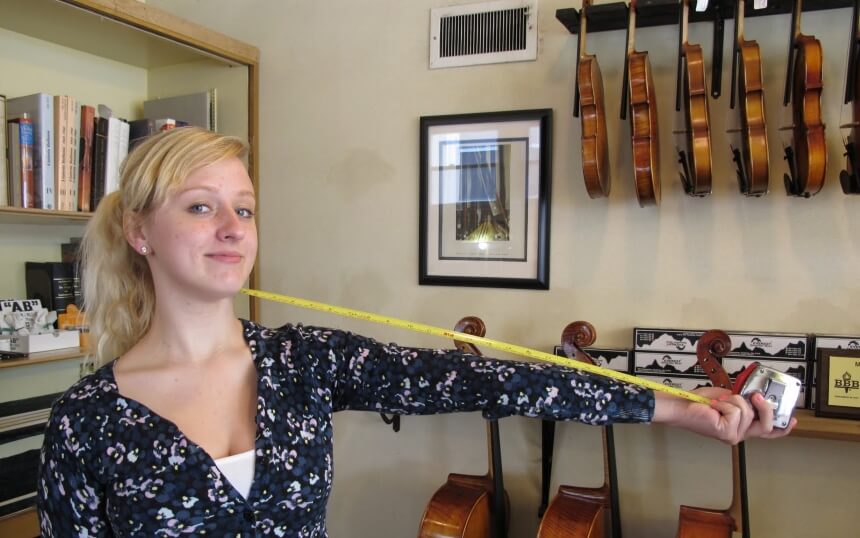There are no specific physical requirements for playing a violin. This is thanks to the wide range of sizes violins come in to suit every violinist with unique body proportions. The sizes range from 1/32 to 4/4. They are 9 different sizes and everyone including young players can get one that suits their body size. Even adults who have small arms and hands can get a violin that they can handle comfortably.
The most asked question by violinist beginners is, ‘what violin size do I need?’ Well, simply put, you must measure the body of the violinist to get the right fit for them. You must consider the length of their neck, shape of their jaw, the length and size of their left hand fingers and the width of their left-hand palm. Getting the measurements right is key to ensuring the violin won’t be too large or too small. The right violin size guarantees a pleasant playing experience. Read on for some more insightful ideas on how to size a violinist’s violin.
A violin too small or too large would be uncomfortable to play. A violin too big for you or your child would be too heavy to carry. You would then end up with a sore neck, back and arms, only if you are lucky to make it through the performance.
Also, if the violin is too big you will have trouble trying to reach the notes. If it’s too hard to lay, you wouldn’t want to play at all.
 There are 9 main sizes of violins. The size of a violin corresponds to the length of its body excluding the scroll and the neck. The sizes range from 1/32 to 4/4 which is a full-size at 14 inches.
There are 9 main sizes of violins. The size of a violin corresponds to the length of its body excluding the scroll and the neck. The sizes range from 1/32 to 4/4 which is a full-size at 14 inches.
This is the smallest violin and is meant for players between 1 and 3 years. Yes! A 1 year old can play a violin. They begin with a cardboard violin to familiarize their hands and body to the playing position. After this, they start using a real violin and the 1/32 is the perfect violin at their age.
The 1/32 violin measures 13½ inches in length. It is perfect for players with 14-inches long arms.
These are like an inch longer than the 1/32 violins. They are meant for violinists between ages 3 and 5. Most beginning students often start at this age. The violins are 14½ inches long and they are best suited for players with 14-inches long arms.
These are 1 ½ inches longer than the 1/16 violins. They are made for kids between ages 4 and 5 who have arms as long as 15 inches. The violins are 16 inches long.
These are also just about an inch longer than the previous size. They are best suited for young players who are 4 to 6yrs old. They are 17 inches long and are perfect for arm length up to 16 ½ inches.
These are made for 5 to 7 year olds. They are 2 inches longer than the 1/8 size and they measure 18 ½ to 19 inches. Anyone who has arms as long as 18 to 18 ½ inches should get these.
The Cecilio Violin For Beginners is one of the most acclaimed violin kit that comes in the 1/4 size. It also comes in the 1/2 and 4/4 sizes. The kit consists of everything a violinist would need including 2 bows, rosin, tuner and a lesson book. You would be ready to play straight out of the box.
These are best suited for student violinists between the ages of 7 and 9. They are 20 ½ inches long, thus perfect for arm lengths of about 20 inches.
These are mostly played by 9 to 12 year olds. They are 21 inches long and they best fit arm lengths of about 21 ½ to 22 inches.
These are not very popular but they are perfect for teenagers and adults who have smaller than average hands. They are 22 ½ inches long and can perfectly fit in 22-inch long arms. They are to come by, but you can make one for yourself or ask you violin store to keep an eye on one for you.
This is the full-size violin and the large on the violin size spectrum. They are mostly played by teens and adults. The violins measure 23 to 23 ½ inches and can fit in arms as long as 23 inches or longer.
Any adult or teenager that is more than 5ft tall can play a full-size violin. However, if you are 5ft tall or more and you have small hands, you can stick to the smaller violin sizes for easier playing.
 So, how do you know the size of violin you need? 2 things; you can either have you violin teacher measure your arm length before you go to a store to purchase one or have the shop you are renting or buying the instrument from do the measurements.
So, how do you know the size of violin you need? 2 things; you can either have you violin teacher measure your arm length before you go to a store to purchase one or have the shop you are renting or buying the instrument from do the measurements.
You will know the violin is the right fit if its total length, including its neck, allows your wrist to curve up and wrap around the scroll. If you find that you or your child is between sizes, it’s better you go smaller than larger.
So many people are unaware age isn’t the main factor in violin sizing. You cannot buy a violin based on height and age alone. Not everyone in the same age bracket will play the same size of violin recommended for his/her age group. A person’s physical features are the main determinant for the size of violin they will be playing.
To get the right size of violin, you must measure the player’s:
While you are in the violin store with the measurements, hold the violin of your choice in playing position and check to see that it is proportionate to your body. Let the store keeper look at the violin’s length compared to your height. If it looks out of proportion even if you can comfortably bend your left arm in playing position, it is too big. Re-measure until you get it right.
Also, if you can’t hold the violin under your chin without using your left arm to support it then it is too big.
If you choose to purchase your first violin online, then you must ensure you get the measurements right. You can have your teacher get the measurements for you beforehand.
If you are not sure of your violin’s size, you can measure it, just in case you need to sell or, hand it down to someone. All you have to do is measure the length of the violin from the top of the scroll to the bottom. Don’t include the end pin at the bottom. Next, measure the violin’s body from its shoulders to the bottom excluding the section that juts-out from the base of the violin’s neck. You can measure the width as well, from one end of the upper or lower bout to another. The width varies across different models and designs.
Other than the violin, the accessories also need to measure up. The bow, strings, shoulder-rest and case also need to get sized alongside your violin. Very often, you will find a violin kit that includes a rosin, strings, bow and case in its package.
When you get a package that doesn’t have any of these items or you choose to buy a violin without any of them, then you have to ensure that each of the items you purchase separately are the same size as the violin.
Once you have the correct measurements for your violin, then you can easily walk into a store and ask for a bow, strings or shoulder rest that match it. For instance, if you have a 4/4 violin, then you’d have to get a 4/4 bow like the famous Vio Music#709 Old German Baroque Style Beautiful Snakewood 4/4 Violin Bow. The bow has the perfect weight, excellent balance and fast response thanks to its painstaking design and durable build. It is also very aesthetic because of its beautiful sankewood stick and genuine white Mongolian horsehair.
You are thinking of commencing violin classes or signing up your kid and the first question that is in your mind as everyone else’s is What size of violin do I need? You can invest in the best violin for your kids or yourself but if it’s not the right fit then you won’t enjoy playing it and that means you won’t get value for your money. Luckily, there is a violin for everyone regardless of their height, age or weight. The 9 different violin sizes cater to nearly every violinist or violin enthusiasts with unique physical proportions.
To get the right size of violin to invest in, you must take accurate measurements of your arm, jaw, neck and left fingers. You can also hold the instrument at the store and ask the attendant to check if it is proportionate to your body size.